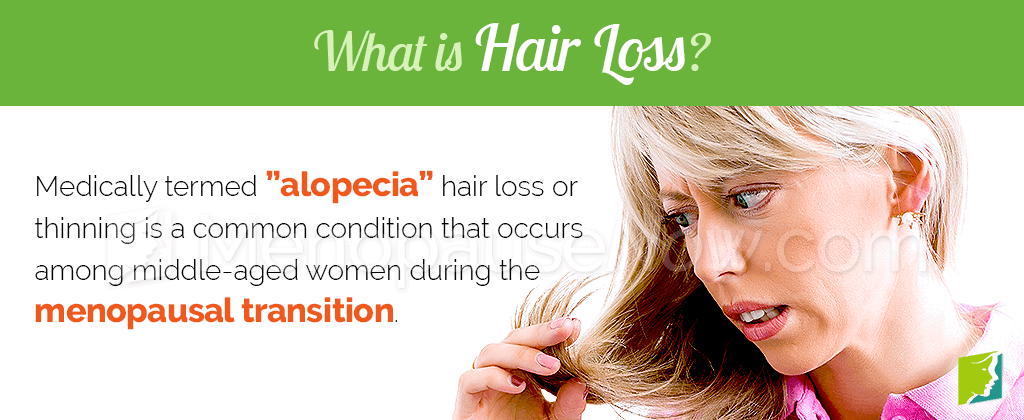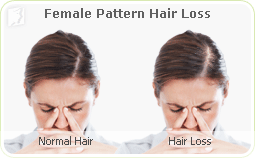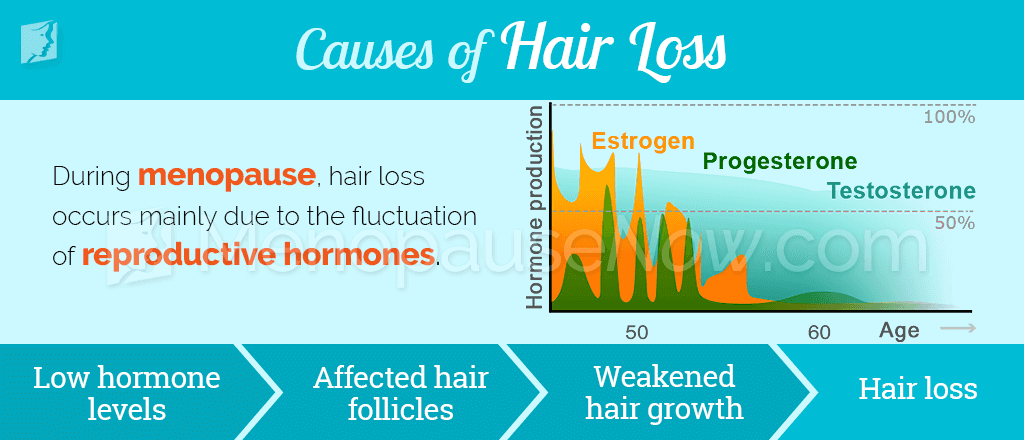Hair loss is a condition traditionally associated with men. However, many women experience it as well, particularly during times of hormonal imbalance, such as menopause. Often, this is one of the first symptoms of menopause that a woman notices. Hair loss can be one of the more disappointing symptoms of menopause, as a woman's hair is associated with her femininity, sexuality, and individual sense of style.
Fortunately, through learning more about how and why it occurs, it is possible to treat hair loss. Keep reading to find out more about hair loss as it occurs in menopause, why it happens, and how to treat it.

About Hair Loss
The average head has approximately 100,000 hairs at any given time. Hair is made primarily of keratin, a protein that also forms the nails and outer layer of skin. Above the surface of the scalp, the part that is brushed and styled, each strand of hair is actually dead tissue that comes from hair follicles, which exist below the scalp's surface. This visible section is called the hair shaft.
Normal hair growth
Hair remains on the head for a length of time between two and six years, during which time it grows continually. This growing phase is known as anagen. By contrast, there is also a resting phase known as telogen, about three months in duration, in which the hair stops growing and ultimately falls out.
It is normal to lose 50 - 100 hairs each day. These are constantly regenerated by the hair follicles. However, it is possible for a far greater loss of hair occur, particularly in perimenopausal women.

Not all hair loss is the same. As it can be caused by a variety of factors, there are a number of ways in which it might manifest itself. When imagining hair loss, many people picture male pattern baldness, which is characterized by a receding hairline and bald patch on top of the head. In menopausal women, this hair loss tends to be more subtle, with an overall thinning in most cases rather than bald spots.
Symptoms of hair loss
As some degree of hair loss is normal, it may be difficult to determine what level of hair loss warrants concern. The following are some of the most commons symptoms of hair loss in menopause:
- Hair falling out in large clumps when shampooing
- Large snarls of hair appearing in the brush or comb
- Small bald patches appearing on the scalp
- Red, oily, or itchy scalp
- Noticeable hair thinning on the front, sides, or top of head
If a woman is experiencing these symptoms, it is likely that hair loss is beyond the normal amount. Click on the following link for more information about the specific types of hair loss during menopause, or continue reading to learn more about the causes of hair loss during menopause.

Causes of Hair Loss
Hair loss during menopause is typically tied to hormone levels, though other factors can also be at play.
Hormonal causes

Hair loss during menopause is usually a direct result of fluctuating hormone levels. Two main hormones are involved in hair growth: estrogen and testosterone. In estrogenic alopecia, the most common type of hair loss in menopausal women, hair loss is directly attributed to declining estrogen levels. Estrogen helps hair grow faster and stay on the head longer, leading to thicker, healthier hair.
Estrogen is not the only hormone that comes into play in menopausal hair loss. Androgens, or male hormones, often increase as estrogen levels decrease. This causes androgenic alopecia, another form of hair loss. An androgen known as dihydrotestosterone (DHT) appears to bind to hair follicles and force them to go into their "resting" phases, or telogen, sooner than normal, causing the new hairs to grow ever thinner with each cycle of hair growth. Testosterone also shrinks hair follicles, causing hair loss on the head but a greater production of facial hair.
It is not only hormones that can cause a decrease in hair production during menopause; there are also several other causes that can lead to hair loss. Keep reading to learn more about other less common causes of hair loss.

Other causes
For menopausal women, hormones typically contribute at least some to hair loss. However, there are many other factors that may also play a role in hair loss during menopause, including medical, psychological, or lifestyle triggers.
Medical Causes
- Pregnancy
- Thyroid disorders
- Pituitary problems
- Anemia
- Chemotherapy
- Chronic illnesses
- Scarlet fever
Psychological Causes
- Anxiety
- Emotional stress
- Traumatic events
- Depression
- Eating disorders
Lifestyle Triggers
- Excess of vitamin A
- Lack of vitamin D
- Iron deficiency
- Lack of protein
- Lack of exercise
- Pulling or twisting hair
Fortunately, through learning more about the causes of hair loss, it is possible to treat it. Click on the following link to find more information about the causes of hair loss during menopause, or read on to find out more about ways to overcome hair loss during menopause.
Hair Loss Treatments

Americans spend one billion dollars per year on hair loss treatments. Unfortunately, according to the American Hair Loss Society, 99% of these treatments are ineffective. For women in particular, most do not want to sit back and let their hair fall out slowly without taking action. Luckily, there are alternative solutions that can be successful for women experiencing hair loss.
Lifestyle adjustments may help. Changes in diet and hair care can alleviate symptoms, since certain nutrients affect the rate of hair growth. Increasing one's intake of protein, vitamin D, and iron all help. Exercise and stress reduction techniques such as yoga or meditation improve overall health, and taking care to not pull or twist hair can minimize damage.

Because a high percentage of hair loss is caused by decreased hormone levels, using alternative treatments that balance hormone levels, such as certain herbal supplements, can help with hair growth. Often, the most effective and safest solution is to combine lifestyle adjustments with alternative treatments.
For extreme cases, there are medications or hair transplant surgeries available, but care should be taken, as these options can be risky and side effects are possible.
Most experts recommend that women who suffer from hair loss and wish to treat it begin first with lifestyle changes, then move on to alternative medicines, and then finally resort to medications or surgery if nothing else seems to work. Click on the following link to learn more about specific treatments for hair loss during menopause.
Sources
- National Health Service UK. (2015). Women and hair loss: coping tips. Retrieved April 14, 2016, from http://www.nhs.uk/livewell/hairloss/pages/womenandhairloss.aspx
- National Institutes of Health. (2014). Female pattern baldness: MedlinePlus Medical Encyclopedia. Retrieved April 14, 2016, from http://www.nlm.nih.gov/medlineplus/ency/article/001173.htm
- National Institutes of Health. (2014). Hypervitaminosis A. Retrieved April 14, 2016, from https://www.nlm.nih.gov/medlineplus/ency/article/000350.htm
- Park, S.Y. et al. (2013). Iron plays a certain role in patterned hair loss. Journal of Korean medical science, 28(6), 934-938. doi: 10.3346/jkms.2013.28.6.934
- Rasheed, H. et al. (2013). Serum ferritin and vitamin D in female hair loss: do they play a role? Skin pharmacology and physiology, 26(2), 101-107. doi: 10.1159/000346698
- Riedel-Baima, B. & Riedel, A. (2008). Female pattern baldness may be triggered by low oestrogen to androgen ratio. Endocrine regulations, 42(1), 13-16. Retrieved from http://www.ncbi.nlm.nih.gov/pubmed/18333699








